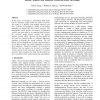Free Online Productivity Tools
i2Speak
i2Symbol
i2OCR
iTex2Img
iWeb2Print
iWeb2Shot
i2Type
iPdf2Split
iPdf2Merge
i2Bopomofo
i2Arabic
i2Style
i2Image
i2PDF
iLatex2Rtf
Sci2ools
INFOCOM
1994
IEEE
1994
IEEE
Traffic Models for Wireless Communication Networks
In this paper, we introduce a deterministic fluid model and two stochastic traffic models for wireless networks. The setting is a highway with multiple entrances and exits. Vehicles are classified as calling or non-calling, depending on whether they have calls in progress. The deterministic model ignores the behavior of individual vehicles and treats them as a continuous fluid, whereas the stochastic traffic models consider the random behavior of each vehicle. However, all three models use the same two coupled partial (or ordinary) differential equations to describe the system evolution. The call density and call handoff rate (or their expected values in the stochastic models) are readily computable by solving these equations. Numerical examples are presented to illustrate how the models can be used to investigate various aspects of time and space dynamics in wireless networks. These examples also show that the models can serve as useful tools for system engineering and planning.
Communications | Deterministic Fluid Model | INFOCOM 1994 | Stochastic Traffic Models | Wireless Networks |
Related Content
| Added | 09 Aug 2010 |
| Updated | 09 Aug 2010 |
| Type | Conference |
| Year | 1994 |
| Where | INFOCOM |
| Authors | Kin K. Leung, William A. Massey, Ward Whitt |
Comments (0)

